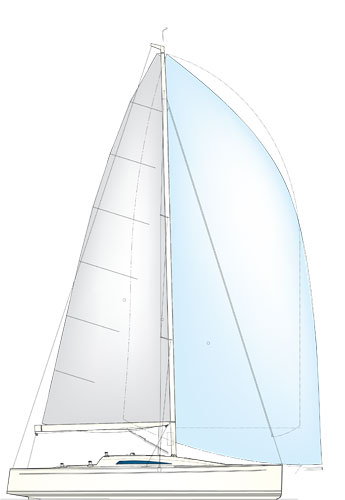Summit 35
Here is another IRC boat from Mark Mills' office in Ireland. More than most designers, Mark seems to have a firm grip on the ways to make the IRC work best at exchanging boat speed for rated speed. The class as a whole is very healthy in Europe and the boats appear to be very well received, probably at least partly due to the fact that the rule encourages accommodations and discourages extremes in design. My only complaint with this design is that it looks similar to other Mills-designed boats. Certainly even the IRC allows some variation in aesthetics. That said, it's a very good looking boat and I'm sure the looks are driven by the rule and the pragmatic aspects of race boat design.
This 35-footer shows fairly high freeboard and about eight inches of bow overhang with another 50 inches of overhang aft. Note that while the rudder blade pierces the DWL it would not usually be counted in the DWL. The D/L ratio is 177.5 and the L/B is 3.08. So you can think of this boat as a medium displacement, beamy design. The IRC is very kind to draft and stability so a big, lead T-bulb is hung off an iron fin drawing 7 feet, 5 inches. I don't see any provision in the specs for a kelp cutter so this keel would pose some kelp issues in Puget Sound. The rudder is a very high-aspect-ratio shape and long in span. It looks to my eye like the rudder blade planform is more than 50 percent of the keel fin planform. It's a very pretty hull shape with a broad stern and generous rocker reflecting the displacement.
The accommodation plan should convince the IRC committee that this really is a dual-purpose boat with equal attention paid to comfort and speed. There are mirror-image double quarterberths. There is a double V-berth forward. The head spans the beam of the boat. This is an old way of laying out a head and I think it is a very effective use of space. Of course it means that access forward is blocked when the head is in use but I don't think this is really a problem. With the entire beam of the boat to work with the head can be spacious with plenty of room for a shower on centerline. The galley is small but adequate. The outboard icebox looks small and awkward to get to. The nav station is generous. I see only one hanging locker in the boat.
The SA/D is 22.88. Consider that in the last days of the CCA rule, the early 1960s, SA/Ds were generally less than 18. With the big mainsail on a long boom it allows the underdeck, German-style mainsheet to lead to a broad traveler abaft (I'm reading Uffa Fox again) the helmsman. Chainplates are external and out at the rail and the spreaders are swept 20 degrees. There is a retractable sprit.
This boat has a tiller as standard and an option for twin carbon pedestals. I like the tiller. There are controls coming out of the cockpit sole right at the feet of the helmsman at the forward end of the foot benson. I'm not sure which lines they are. I'd guess traveler controls.
Mark does good work and the race results prove it. It's good to see truly dual-purpose boats making a comeback.
LOA 35'1"; LWL 30'2"; Beam 11'5"; Draft 7'5"; Displacement 10,920 lbs.; Ballast 5,300 lbs.; Sail area 704 sq. ft.; SA/D 22.8; D/L 177.5; L/B 3.08; Auxiliary Volvo 28-hp; Fuel 17 gals.; Water 32 gals.
Summit Yachts, www.summit-yachts.com. For sales, contact McMichael Yacht Brokers, 447 E. Boston Post Rd., Mamaroneck, NY 10543, (914) 381-5900, info@mcmyacht.com.
OBE: $295,000
Our Best Estimate of the sailaway price

Comments